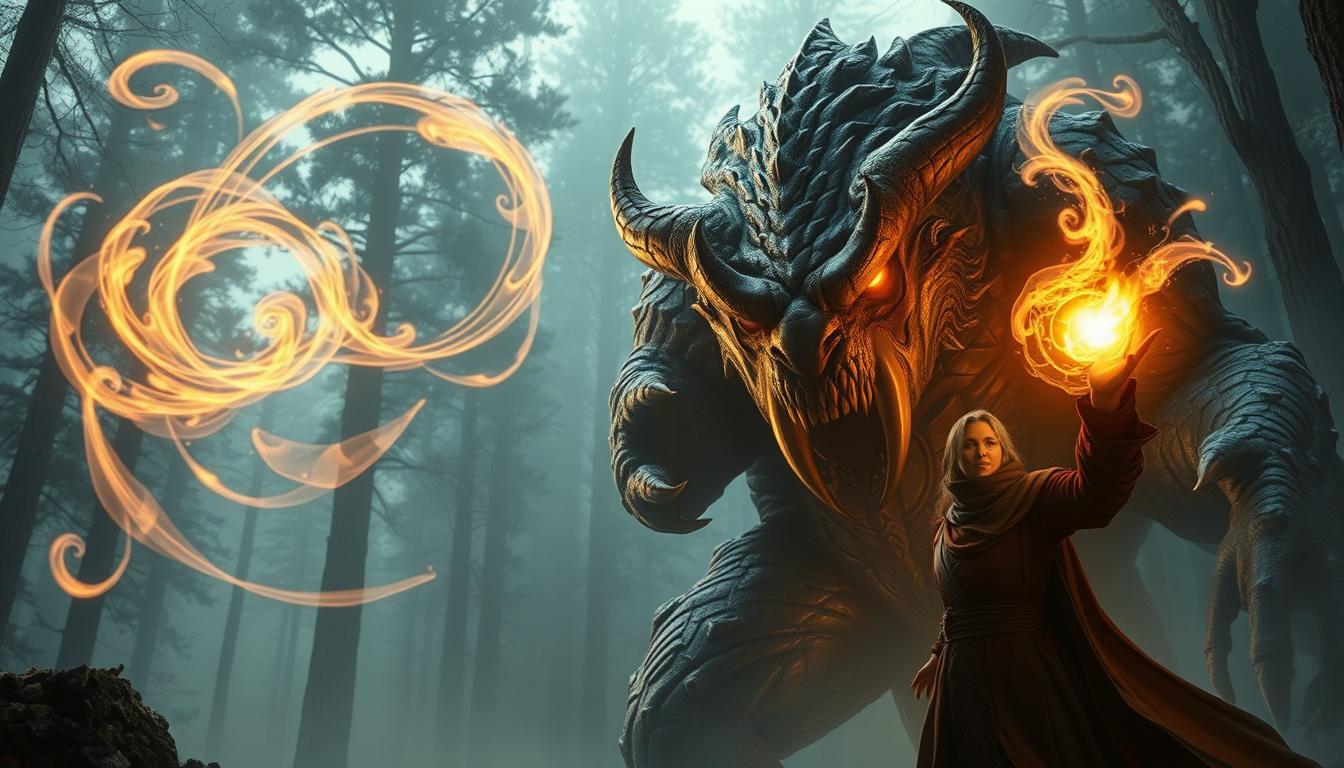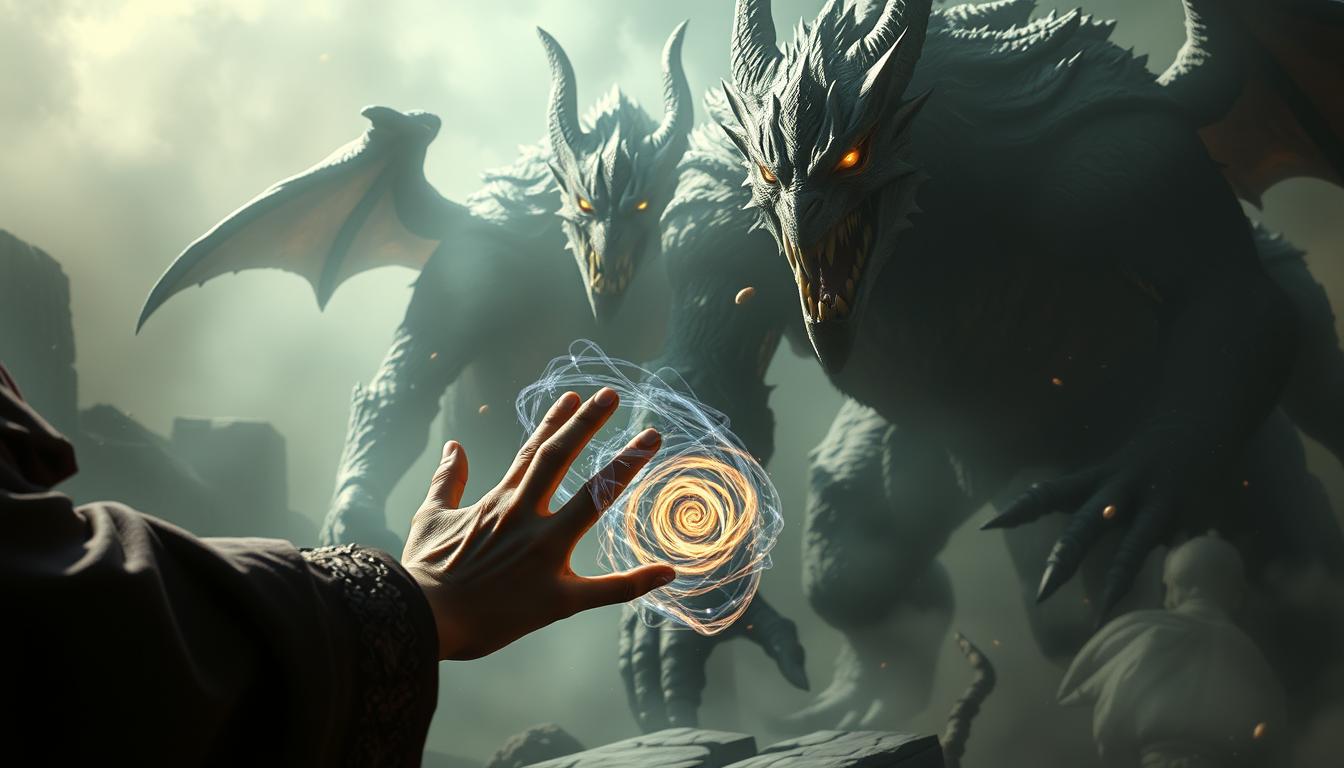Charm Monster 5e: What You Need to Know for Your Campaign
When I first used the Charm Monster 5e spell in my Dungeons & Dragons campaign, it completely changed how I approached encounters. This spell isn’t just about avoiding combat—it’s a tool for creating memorable moments and turning potential enemies into allies. Whether you’re a seasoned player or just starting, understanding its mechanics can elevate your gameplay.

In this guide, I’ll share my personal experiences and the strategies I’ve discovered through trial and error. From casting time to duration, I’ll break down everything you need to know to master this spell. Whether you’re looking to avoid a tough fight or navigate a tricky social situation, this guide has you covered.
Key Takeaways
- Charm Monster 5e is a versatile spell for both combat and social encounters.
- It has a casting time of 1 action and lasts up to 1 hour.
- Available to bards, druids, sorcerers, and warlocks.
- Great for turning hostile creatures into temporary allies.
- Useful for avoiding unnecessary battles in your campaign.
Introduction to Charm Monster 5e
My first encounter with this spell was during a tense troll encounter. I was out of options, and the troll was closing in. Casting it turned the tide, making the troll see me as a friend. That moment showed me how powerful this enchantment could be.
In Dungeons & Dragons, enchantment magic focuses on influencing minds. This spell is a prime example. It allows you to sway a creature’s emotions, making them see you as an ally. It’s not just about avoiding fights—it’s about creating opportunities.

This spell is available to several classes: Bard, Druid, Sorcerer, Warlock, and wizard. Each class gains access at level 4. It’s a versatile tool for anyone who wants to navigate encounters creatively.
One key difference between this and Charm Person is its target. While Charm Person works on humanoids, this spell is perfect for non-humanoid creatures. Whether it’s a beast, aberration, or monstrosity, this enchantment can turn them into temporary allies.
| Feature | Charm Monster | Charm Person |
|---|---|---|
| Target | Non-humanoid creatures | Humanoids |
| Duration | Up to 1 hour | Up to 1 hour |
| Classes | Bard, Druid, Sorcerer, Warlock, Wizard | Bard, Sorcerer, Wizard |
How Charm Monster 5e Works
The way this spell functions is both simple and deeply strategic. To use it effectively, you need to understand its mechanics, from casting time to how the target reacts. Let’s break it down step by step.

Casting Time and Range
This spell takes just 1 action to cast, making it quick and versatile in combat. Its range is 30 feet, so you’ll need to be close enough to your target but not so close that you’re in immediate danger. Timing is everything—use it when the moment is right.
Saving Throw and Duration
The target must make a Wisdom saving throw. If they fail, they’re charmed for up to 1 hour. In combat, they have advantage on the save, so it’s trickier to pull off. I once tried it on a mind flayer, and it failed spectacularly—lesson learned!
During that 1-hour duration, the charmed creature sees you as a friendly acquaintance. This opens up creative opportunities, like negotiating a truce, setting traps, or even orchestrating an escape. But be careful—if your allies deal damage to the creature, the effect ends immediately.
Once the spell wears off, the target realizes they were influenced. This can lead to some awkward—or dangerous—situations. Plan ahead to avoid backlash.
When to Use Charm Monster 5e
One of the most memorable moments in my campaign was using this spell to turn a hostile creature into an ally. It’s a powerful tool, but timing and strategy are key. Let’s explore the best and worst times to cast it.
In my experience, this spell shines in specific scenarios. For example, I once used it to negotiate with a troll guarding a bridge. Instead of fighting, we struck a deal. Another time, I distracted a displacer beast while my party sneaked past. These moments show how versatile it can be.

However, there are times when casting it is a bad idea. Avoid using it during active AoE effects or when your party is dealing damage. The spell ends if the creature is harmed by you or your allies, so coordination is crucial.
Combining this spell with a party face character can boost its effectiveness. If you have a bard or paladin with high persuasion, they can take advantage of the creature’s friendly attitude. This teamwork can lead to creative solutions.
It’s also better suited for solitary monsters rather than groups. Trying to charm multiple enemies at once rarely works out. I learned this the hard way when I attempted to charm a gelatinous cube—it didn’t end well.
| Scenario | Effectiveness |
|---|---|
| Solitary monsters | High |
| Groups of enemies | Low |
| During AoE effects | Risky |
Mastering this spell takes practice, but when used correctly, it can turn the tide of any encounter. Just remember to plan ahead and choose your moments wisely.
Advantages and Limitations of Charm Monster 5e
Exploring the benefits and drawbacks of this enchantment has been a game-changer in my campaigns. It’s a powerful tool, but like any spell, it has its strengths and weaknesses. Understanding these can help you use it more effectively in your adventures.

Advantages
One of the biggest advantages is its versatility. It can turn a hostile target into a temporary ally, giving you time to strategize or escape. The spell’s components are simple, making it easy to cast in tight situations.
Another benefit is its duration. Lasting up to an hour, it provides ample time to negotiate or set up a plan. I’ve used it to distract guards while my party sneaked past, and it worked like a charm—pun intended.
It’s also great for avoiding unnecessary fights. If you’re outnumbered or low on resources, this spell can be a lifesaver. Just remember, timing is everything.
Limitations
Despite its strengths, this spell has some notable limitations. High-WIS creatures often ruin your plans. They have a better chance of succeeding on their saving throw, especially if they’re threatened.
Combat restrictions make timing crucial. If your allies deal damage to the target, the spell ends immediately. This can be frustrating if your party isn’t coordinated.
Language dependency is another issue. Complex commands may not work if the target doesn’t understand you. This limits its effectiveness in certain scenarios.
Smart DMs can also make charmed creatures “help” in inconvenient ways. I once had a charmed ogre carry me away from the battle—not exactly what I had in mind.
Lastly, it’s a concentration spell. If you’re already maintaining another spell, this can create conflicts. Always weigh your options before casting.
| Advantages | Limitations |
|---|---|
| Versatile in various scenarios | High-WIS creatures often resist |
| Lasts up to 1 hour | Combat restrictions can end the spell early |
| Great for avoiding fights | Language dependency limits commands |
| Simple components | Concentration conflicts with other spells |
Strategies for Maximizing Charm Monster 5e
Mastering this enchantment requires more than just casting it—it’s about strategy and timing. Over the years, I’ve discovered several tactics to make this spell work in my favor. Here are my go-to strategies for maximizing its potential.
One of my favorite combos is pairing it with Silence. This ensures a quiet takedown, especially in stealth-heavy scenarios. By eliminating noise, you can cast the spell without alerting nearby enemies. It’s perfect for infiltrating guarded areas or avoiding unnecessary attention.
Surprise rounds are another great opportunity. If you catch a creature off guard, they won’t have advantage on their saving throw. This increases your chances of success, especially against high-WIS targets. Timing is everything—use it before combat fully initiates.

I’ve also used this spell as a scouting tool. A charmed creature can provide valuable information or even lead you through dangerous areas. Just be cautious—some DMs may interpret the creature’s actions differently, so always plan for contingencies.
Upcasting is another creative tactic. By using higher-level slots, you can target multiple creatures or extend the duration. This is particularly useful for dungeon infiltration or dealing with groups. However, remember that the spell’s effectiveness still depends on saving throws and DM interpretation.
| Strategy | Effectiveness |
|---|---|
| Silence + Charm Monster | High for stealth scenarios |
| Surprise rounds | Increases success rate |
| Scouting tool | Useful for information gathering |
| Upcasting | Great for multiple targets |
Finally, always communicate with your DM. Variations in interpretation can affect how the spell works in your campaign. By understanding their perspective, you can adapt your strategies and avoid unexpected surprises.
Conclusion
This enchantment has reshaped how I approach encounters in my D&D sessions. As a warlock main, it’s become a cornerstone of my strategy, turning potential threats into temporary allies. Its versatility has encouraged me to think beyond combat, exploring creative solutions in every campaign.
Don’t limit yourself to the obvious uses. Experiment with this spell in unexpected ways—like scouting or setting traps. During session zero, discuss with your DM how it fits into your game. Clear communication ensures everyone’s on the same page.
For high-level play, consider pairing it with other abilities for advanced combos. The possibilities are endless, and I’d love to hear how you’ve used it in your adventures. Share your experiences in the comments below!